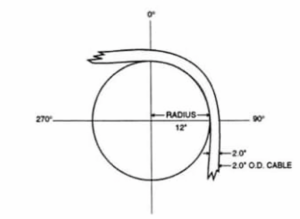What is Minimum Bend Radius?
The minimum bend radius is the smallest allowed radius the cable is allowed to be bent around. During installation, cables are bent or flexed in various environmental conditions. Cables are often bent around a curve in conduits or underground ducts. Cables are also bent when pulling a cable around a sheave, which is a pulley set up in a manhole to help ease a cable around a curve.
Cables are composed of different components that may become compromised if bent too far and stress is placed on the cable. For example, while bending a medium-voltage cable consisting of a copper tape shield, the cable may form cracks in the outer jacket. To prevent cable damage, cable standards such as The National Electrical Code (NEC) and the Insulated Cable Engineers Association (ICEA) formed requirements for minimum bend radius.
How to Calculate Minimum Bend Radius?
Figure 1 shows a cable with an outer diameter of 2 inches being bent around a radius of 12 inches.

The minimum bend radius is based on the diameter of the cable and the type of cable.
The following formula is used:
Minimum Bend Radius =
Cable Outer Diameter x Cable Multiplier
Figure 1: Minimum Bend Radius
Cable Multipliers
Cable multipliers are determined by industry standards and vary depending on the cable type.
Table 1 provides a general guide on cable multipliers for various cable types. Please note that the multiplier may change depending on the cable type and industry standard. For more information, see 2014 NEC Articles 300.34, 330.24 and 336 as well IEEE 1185, ICEA S-75-381, ICEA S-66-524 and ICEA S-68-516.
| Cable Type | Minimum Bend Radius as a Multiple of Overall Cable Diameter |
| Single or multiple-conductor cables without metallic shielding, >1,000 V | Eight times the overall cable diameter1 |
| Single-conductor cables with shielding, >1,000 V |
12 times the overall cable diameter1 |
| Multiconductor cables with individually shielded conductors >1,000 V | 12 times the individual conductor diameter or seven times the overall cable diameter — whichever is greater1 |
| Portable (mining) cables | Six times for cables rated 5000 volts or less, eight times for cables rated over 5,000 volt2 |
| Interlocked armor or corrugated sheath (Type MC) cables |
Seven times overall cable diameter3 |
| 1 2014 NEC Section 300.34 Conductor Bend Radius
2 ICEA S-75-381 Portable and Power Feeder Cables for Use in Mines and Similar Applications 3 2014 NEC Section 330.24 Bending Radius |
|
Table 1: Cable Multipliers for Minimum Bend Radius
Minimum Bend Radius Calculation Example
Example: What is the minimum bend radius of a 1/0, 5 kV, SHD-GC cable?
Answer: SHD-GC is a shielded mining cable. According to Table 1, the minimum bend radius is found to be six times the cable’s overall diameter. The overall diameter of the cable is given as 2.08 inches in the product catalog. Multiplying 2.08 inches by six, we get 12.48 inches. The minimum bending radius for this SHD-GC cable is approximately 12.5 inches. This cable can be safely bent around a diameter of 25 inches.
For help choosing the best cable for your application, visit anixter.com/contact to speak to an expert.






























































